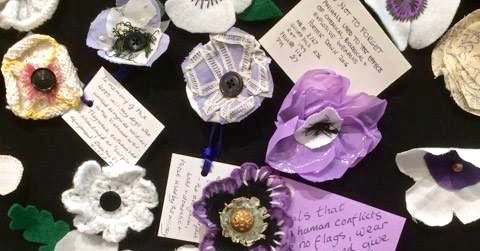
2018 marks 100 years since the end of WW1. To remember the human victims of war, the Collateral Damage Project (CDP) is staging a significant exhibition during November and December of this year at Friends House in London. It will display the CDP white peace poppies installation, begun last year for the Art at the Arms Fair, and which continues to grow…
Quaker Concern for Animals is among those invited to take part in this artwork by making and contributing purple poppies in memory of all nonhuman animals who, alongside humans, die as a result of warfare. It is hoped that these will form a distinctive group within the installation. This is a great opportunity for people (not just Quakers) to create awareness of the continued suffering of millions of domestic, zoo, farm and wild animals, as well as those used by the military on battlefields and in weapons experiments.
The purple poppy, should be roughly the size of the traditional remembrance day poppy and can include white if you wish. Be imaginative with decoration – knot, crochet, felt, stitch, maybe using recycled materials, buttons and fringing for stamens, etc… You can attach to your poppy a message (string and tag) in memory of animal victims. You could cut your tag into a simple animal, bird or insect shape of your choice (war has no respect for species). Work as individuals or in a group – making poppies can be an all-age craft activity.
Your completed purple poppies for the installation should be sent to: Collateral Damage White Poppies, c/o Quaker Peace and Social Witness, Friends House 173-177 Euston Rd, London NW1 2BJ. Deadline is 8 October.
More about the CDP and the poppies installation can be found on the Peace Pledge Union (PPU) website, where there is also a useful *leaflet to download on how to make the poppies: http://www.ppu.org.uk/collateral-damage/
Figures for animal deaths through war are largely unrecorded but here are just a few from military records and others:
* Between 400,000 (the ‘official’ version) and 750,000 dogs and cats, mostly in the London area, were killed in the first four days of World War Two.
* In WW1 alone, an estimated eight million horses, mules and donkeys died. The survivors were sold off, killed or abandoned.
* Around 20,000 military pigeons were killed during WW1.
* 20,000 dogs were trained under battle conditions for carrying messages, scouting and acting as sentries. Many were strays or came from UK dogs’ homes. 7000 pets were handed over. Those who passed training were sent to the front. Those who failed were put down.
* An estimated 5000 working dogs (some figures quote 4000) were taken by US forces to Vietnam for mine, ambushes and booby trap detection. Fewer than 200 were returned home. The survivors left behind were classified as ‘equipment’ and were killed or abandoned. A few were handed over to the South Vietnamese military and police.
* Around 120,000 camels were used by the British military in WW1. It’s estimated that 24,000 were killed in action with many more dying from disease, exhaustion and neglect.
* In 1946 the ‘Atomic Ark’ involved 4000 animals, including sheep and goats being set adrift in a boat near Bikini Atoll in the South Pacific. An atomic blast was detonated above them to gauge the effects. All were either killed or badly burned.
In 2017, the international charity Four Paws worked with the Turkish environment ministry to rescue surviving animals from the abandoned Aalim al-Sahar zoo in Aleppo, Syria, after six years of war. Local people had worked hard to keep the surviving animals alive before NGO help arrived.
Ann Johnson, Quaker Concern for Animals. www.quaker-animals.co.uk
